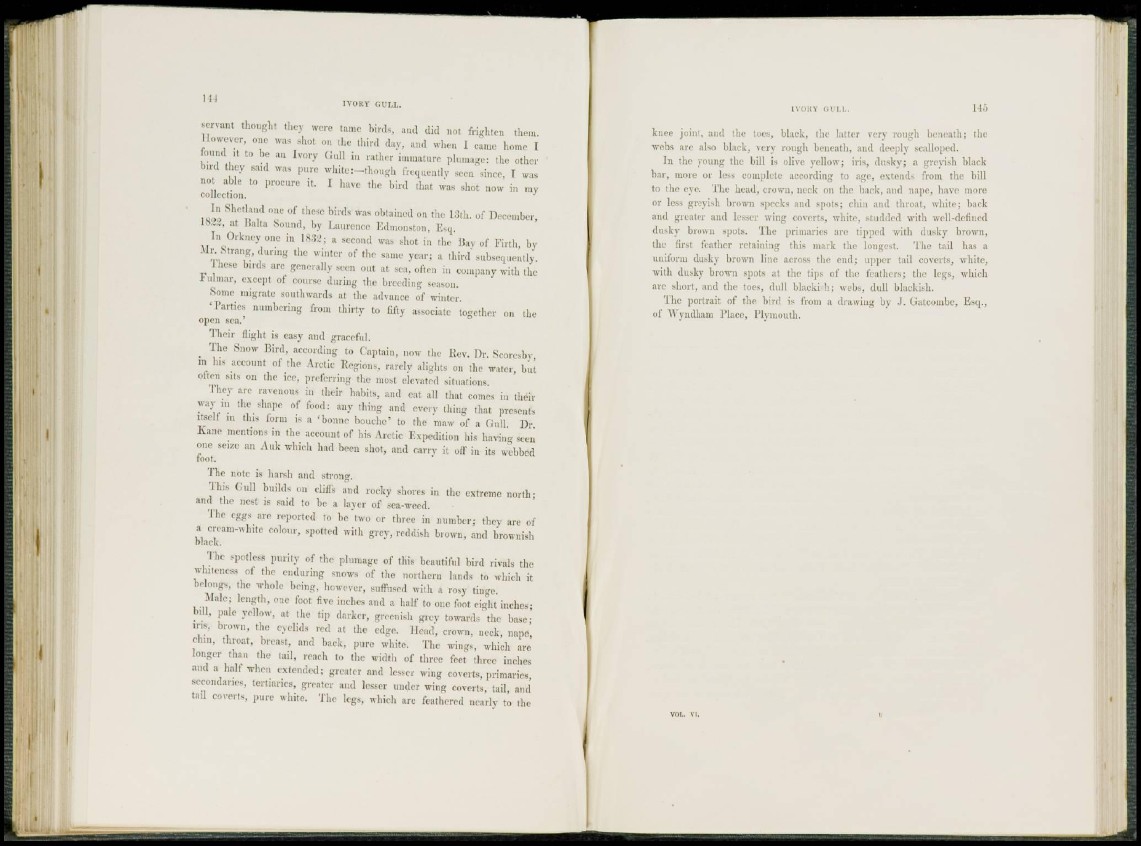
servant thought they were tame birds, and did not frighten them.
However, one was shot on the third day, and when I came home I
found it to be an Ivory Gull in rather immature plumage: the other
bird they said was pure white:—though frequently seen since, I was
not able to procure it. I have the bird that was shot now in my
collection.
In Shetland one of these birds was obtained on the 13th. of December,
1822, at Balta Sound, by Laurence Edmonston, Esq.
In Orkney one in 1832; a second was shot in the Bay of Firth, by
.Mr. Strang, during the winter of the same year; a third subsequently.
These birds are generally seen out at sea. often in company with the
Fulmar, except of course during the breeding season.
Some migrate southwards at the advance of winter.
' Parties numbering from thirty to fifty associate together on the
open sea.*
Their flight is easy and graceful.
The Snow Bird, according to Captain, now the lie v. Dr. Scoresbv,
in his account of the Arctic Regions, rarely alights on the water, but
ofier) sits on the ice. preferring the mosl elevated situations.
They are ravenous in their habits, and eat all that comes in their
way in the shape of food: any thing and every thing that presents
itself in this form is a 'bonne bouchc' to the maw of a Gull. Dr.
Kane mentions in the account of his Arctic Expedition his having seen
one sei/e an Auk which had been shot, and carry it off in its webbed
foot.
The note is harsh and strong.
This Gidl builds on cliffs and rocky shores in the extreme north;
and the nest is said to be a layer of sea-weed.
'[lie eggs are reported to he two or three in number; they are of
a crcam-wlnte colour, spotted with grey, reddish brown, and brownish
black.
The spotless purity of the plumage of this beautiful bird rivals the
whiteness of the enduring snows of the northern lands to which it
belongs, the whole being, however, suffused with a rosy tinge.
Male; length, cue loot five inches and a half to one foot eight inches;
bill, pale vellow, at the tip darker, greenish grcv towards the base;
iris, brown, the eyelids red at the edge. Head, crown, neck, nape,
chin, throat, breast, and back, pure white. The wings, which are
longer than the tail, reach to the width of three feet three inches
and a half when extended; greater and lesser wing coverts, primaries,
secondaries, tertiaries, greater and lesser under wing coverts, tail, and
tail coverts, pure white. The legs, which arc feathered nearly to the
knee joint, and the toes, black, the latter very rough beneath; the
webs are also black, very rough beneath, and deeply scalloped.
Tn the young the bill is olive yellow; iris, dusky; a greyish black
bar, more or less complete according to age, extends from the bill
to the eye. The head, crown, neck on the hack, and nape, have more
or less greyish brown specks and spots; chin and throat, white; back
and greater and lesser wing coverts, white, studded with well-defined
dusky brown spots. The primaries are tipped with dusky brown,
the first feather retaining this mark the longest. The tail has a
uniform dusky brown line across the end; upper tail coverts, white,
with dusky brown spots at the tips of the feathers; the legs, which
arc short, and the toes, dull blackish; webs, dull blackish.
The portrait of the bird is from a drawing by J. Gatcombe, Esq.,
of Wyndham Place, Plymouth.